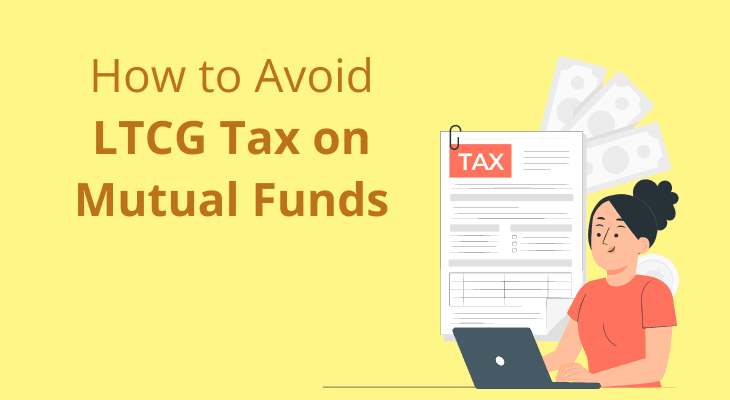
How to Avoid LTCG Tax on Mutual Funds
Investing in mutual funds is an excellent way to grow your wealth, but taxes such as Long-Term Capital Gains (LTCG) tax can reduce your returns. Understanding how to manage and possibly reduce your LTCG tax liability can help you keep more of your earnings. This blog will guide you through what LTCG tax is, how it applies to mutual funds, and strategies to minimise the tax's impact on your investments.
Understanding Long-Term Capital Gains Tax on Mutual Funds
LTCG tax, or Long-Term Capital Gains tax, is a tax levied on the profit you earn from selling mutual fund units after holding them for a specified period. In India, different tax rates apply depending on the type of mutual fund. Here's how it works:
- Equity mutual funds: If you hold your investment for more than one year, the gains are classified as long-term. For these funds, the LTCG tax is 12.5% of profits over ₹ 1.25 Lakhs for the fiscal year. Prior to 23 July, 2024, the exception limit was ₹ 1 Lakh and the LTCG tax was levied at 10% of the profits over this amount. It's essential to note that no indexation benefit is available for equity funds, meaning inflation is not considered when calculating the taxable gain.
- Debt mutual funds: In contrast, gains on debt funds are taxed as per your income slab rate. Before 01 April, 2023, holding debt funds for over three years qualified your gains as long-term. The long-term capital gain tax on debt mutual funds was 20%. Moreover, you could also benefit from indexation, which adjusted the cost of your investment to account for inflation, potentially reducing the taxable amount. This has, however, been removed now.
How to Reduce LTCG Tax on Mutual Funds
Though avoiding LTCG tax on mutual funds entirely is not feasible, several strategies can help reduce your tax burden:
1. Utilise the ₹ 1.25 Lakhs Exemption
For equity mutual funds, you only pay LTCG tax on gains above ₹ 1.25 Lakhs in a financial year. By carefully timing the sale of your units, you can keep your gains under this threshold and avoid paying LTCG tax.
2. Opt for a Systematic Withdrawal Plan (SWP)
A Systematic Withdrawal Plan allows you to withdraw small amounts regularly, spreading your capital gains across multiple years. This can help keep your annual gains below ₹ 1.25 Lakhs, reducing or even eliminating your LTCG tax liability.
3. Tax Harvesting
Tax harvesting involves selling your mutual fund units when your gains are below ₹ 1.25 Lakhs and repurchasing them immediately. This process helps reset your purchase price higher, potentially lowering your future tax liability while staying within the ₹ 1.25 Lakhs exemption.
4. Split Investments Among Family Members
Distributing investments among your family members allows each person to take advantage of the ₹ 1.25 Lakhs exemption. By holding mutual funds in your spouse's or children's names, you can multiply the exemptions and reduce the overall LTCG tax on your family’s investments.
5. Invest in Equity-Linked Savings Schemes (ELSS)
ELSS funds are tax-saving mutual funds that qualify for deductions under Section 80C of the Income Tax Act. While this doesn't directly reduce LTCG tax, the savings under Section 80C can offset the tax on other investments. It is important to know that unlike regular equity funds, ELSS funds come with a three year lock-in period.
6. Use Debt Funds for Short-Term Needs
Debt funds such as liquid funds or overnight funds can be used to park your additional cash. They are highly liquid and may be more tax-efficient, if you fall under a low income tax bracket. Pensioners and retirees often a combination of equity and debt funds to maximise their tax benefits.
Why Holding Your Investment Makes Sense
While selling your mutual funds can trigger LTCG tax, holding on to your investments often proves to be the smarter option. Here are several reasons why:
Compounding Returns
The longer you stay invested, the greater the compounding effect on your returns. Compounding allows your earnings to generate further earnings, significantly boosting your wealth over time, which can offset the impact of LTCG tax.
Deferring Tax Payments
Selling your mutual fund units leads to an immediate tax event. By holding your investment, you defer tax payments, allowing more of your money to remain invested and continue growing.
Favourable Tax Rates
Long-term capital gains are taxed at a lower rate than short-term gains. For instance, the LTCG tax rate on equity mutual funds is 12.5%, while short-term capital gains are taxed at 20%. Earlier, these rates were 10% and 15% respectively. Holding for the long term ensures you're taxed at a more favourable long-term rate.
Lower Transaction Costs
Frequent buying and selling of mutual funds lead to transaction costs, such as brokerage fees and taxes. By staying invested, you minimise these costs, preserving more of your returns.
Mitigating Market Volatility
Markets can be volatile in the short term, but holding your investment for the long term allows you to ride out temporary downturns and benefit from eventual market recovery.
Ways to Lower LTCG Tax on Mutual Funds
Several exemptions and deductions are available to help reduce your LTCG tax liability on mutual funds:
₹ 1.25 Lakhs Exemption for Equity Funds
As mentioned earlier, equity mutual funds enjoy a ₹ 1.25 Lakhs exemption on long-term gains each financial year. By timing your withdrawals strategically, you can avoid LTCG tax up to this amount.
Indexation Benefit for Debt Funds
For debt mutual funds, indexation adjusts your purchase price to account for inflation, significantly reducing your taxable gains. This is one of the most effective ways to lower your LTCG tax liability on debt mutual funds.
Set-Off Against Capital Losses
You can offset your LTCG against capital losses incurred during the same financial year or carried forward from previous years. This reduces your overall taxable gains, lowering your LTCG tax liability.
Tax Harvesting
As discussed earlier, tax harvesting helps reset your investment's purchase price, potentially lowering your future LTCG tax liability. This strategy is particularly useful for investors approaching the ₹ 1.25 Lakhs exemption limit.
Equity-Linked Savings Schemes (ELSS)
While ELSS investments don’t directly reduce LTCG tax, they offer deductions under Section 80C, which can help offset your overall tax burden.
The Effect of Securities Transaction Tax (STT) on LTCG Tax
Securities Transaction Tax (STT) is another consideration when calculating taxes on mutual funds. While it is separate from LTCG tax, it can impact your overall returns.
What is STT?
STT is a tax levied on the purchase and sale of securities listed on recognised stock exchanges in India, including equity-oriented mutual funds. The rate for selling equity mutual fund units is 0.001%, while no STT is charged on purchases. STT is not levied on the purchase or sale of debt mutual funds.
How STT Impacts LTCG Tax
Although STT is a small percentage of your transaction, it does increase the overall cost of your investment. Importantly, paying STT is required for equity investments to qualify for the beneficial LTCG tax rate of 10%. But unlike other taxes, your LTCG tax liability cannot be decreased by STT. For long-term investors, the impact of STT is minimal, but active traders may find that frequent buying and selling incur significant transaction costs.
Conclusion
Managing LTCG tax on mutual funds is essential to maximising your returns. While you can't entirely avoid LTCG tax, you can implement strategies to minimise its impact. Planning your withdrawals to take advantage of the ₹ 1.25 Lakhs exemption, using systematic withdrawal plans, and leveraging tax harvesting are all effective ways to reduce your LTCG tax liability. Additionally, holding your investments for the long term allows you to benefit from compounding returns and favourable tax rates.
FAQ
What is the LTCG tax rate on equity mutual funds?
The LTCG tax rate on equity mutual funds is 12.5% on gains exceeding ₹ 1.25 Lakhs in a financial year.
Can I completely avoid LTCG tax on mutual funds?
While it is not possible to avoid LTCG tax entirely, you can reduce it by utilising strategies like the ₹ 1.25 Lakhs exemption and tax harvesting.
What is tax harvesting, and how does it help reduce LTCG tax?
Tax harvesting involves selling your mutual fund units when your gains are below ₹ 1.25 Lakhs and repurchasing them. This resets your purchase price, potentially reducing future LTCG tax liability.
Do debt mutual funds qualify for the ₹ 1.25 Lakhs exemption?
No, the ₹ 1.25 Lakhs exemption applies only to equity mutual funds. Debt mutual funds are taxed at your existing income tax slab.
What is indexation, and how does it reduce tax on debt mutual funds?
Indexation adjusts your purchase price for inflation, lowering your taxable gains and reducing your LTCG tax liability on debt mutual funds.
Are debt mutual funds taxed the same way as equity mutual funds for LTCG?
No, debt mutual funds are taxed as per your income tax slab, while equity mutual funds have a 12.5% LTCG tax on gains above ₹ 1.25 Lakhs, without indexation. The rate was 10% earlier, and the limit was ₹ 1 Lakh.
What is the Securities Transaction Tax (STT), and does it affect LTCG tax on mutual funds?
STT is levied on equity mutual fund sales. It doesn’t reduce LTCG tax but is necessary for equity funds to qualify for the 10% LTCG rate.
Can I offset LTCG tax on mutual funds with capital losses?
Yes, long-term capital losses can offset long-term capital gains, reducing your LTCG tax liability. This can apply within the same financial year or with losses carried forward.
Does investing in ELSS funds help in reducing LTCG tax?
ELSS funds offer Section 80C tax deductions, but they still incur LTCG tax above ₹ 1.25 Lakhs. These funds reduce overall tax liability but not directly LTCG. Remember, ELSS funds come with a 3-year lock-in.
How is LTCG tax calculated if I switch between mutual fund schemes?
The LTCG is calculated based on the difference between the value at the time of switching and the original purchase cost of the mutual fund units.


